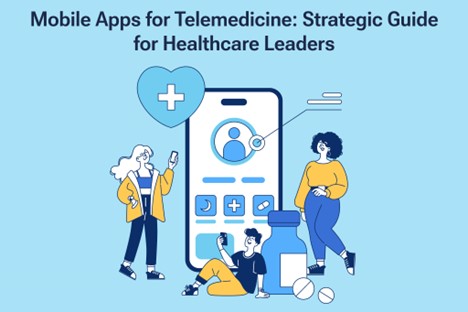Telemedicine has moved beyond a convenient alternative to in-person visits—it’s now a strategic pillar for delivering accessible, patient-centered care. Mobile apps, in particular, are revolutionizing how healthcare services are delivered and consumed.
With smartphones in nearly every hand, telemedicine mobile apps offer unmatched convenience, real-time communication, and scalable care delivery across urban and rural geographies.
As healthcare leaders seek to modernize infrastructure and meet rising patient expectations, investing in telemedicine mobile app development is no longer optional. Partnering with a mobile app development company in USA can ensure HIPAA compliance, intuitive design, and future-ready features tailored for your healthcare goals.
This blog serves as a strategic guide for telemedicine mobile app development.
Why Should You Develop a Telemedicine Mobile App
Here are several benefits of telemedicine app development:
1. Patient-Centric Convenience
Mobile apps in healthcare industry allow patients to consult physicians, receive diagnoses, track prescriptions, and access lab reports—without leaving home. This is especially crucial for elderly patients, individuals with disabilities, or those in remote locations.
2. Cost-Efficiency for Providers
Telemedicine apps help cut operational expenses by reducing reliance on physical infrastructure and streamlining administrative processes. Physicians can optimize their schedules, reduce no-shows, and handle more appointments via asynchronous or live video consultations.
3. Scalability and Reach
Whether you’re a private practitioner or a multi-specialty hospital chain, patient centric healthcare apps make healthcare scalable. They support remote consultations, second opinions, post-operative care, mental health counseling, chronic disease management, and more.
4. 24/7 Access and Emergency Support
Telemedicine apps enable round-the-clock support. Patients can speak to chatbots or live doctors anytime—critical during emergencies or after-hours situations.
Key Features of a Successful Telemedicine Mobile App
1. Secure Video Conferencing: A HIPAA-compliant, high-quality video chat function is the backbone of telemedicine. It should support real-time interaction between doctors and patients with minimal lag.
2. Patient & Doctor Profiles: Allow detailed profile creation, including medical history, photos, prescriptions, certifications, and availability schedules.
3. Appointment Booking & Calendar Sync: Patients must be able to book, reschedule, or cancel appointments easily. Integrating calendar sync and push reminders reduces no-shows.
4. EHR Integration: Seamless access to Electronic Health Records allows doctors to make informed decisions during virtual consultations. Integrating ERP in healthcare system ensures centralized management of patient data, billing, staff availability, and inventory.
5. ePrescriptions: Enable physicians to generate digital prescriptions that patients can access within the app or forward to a partner pharmacy.
6. Chat and Notifications: Support real-time or asynchronous chat between patients and healthcare staff. Automated reminders for medicine intake, appointments, or lab reports add value.
7. Payment Gateway Integration: In-app payment for consultations, insurance co-pays, or subscription plans ensures convenience. Include options like credit/debit cards, UPI, digital wallets, or third-party payers.
8. Multi-Platform Support: Ensure your app is available on both Android and iOS. A web-based version enhances accessibility for older users or those without smartphones.
9. Analytics Dashboard: Offer analytics for both patients (e.g., health trends, vitals) and providers (e.g., appointments, revenue, user behavior) to make data-driven decisions.
Types of Telemedicine Apps You Can Build
Understanding your audience and use-case is critical before starting telemedicine mobile app development. Here are common types:
1. On-Demand Teleconsultation Apps: Patients connect with available doctors instantly. Ideal for general health issues, mental health, and post-surgery queries.
2. Chronic Disease Management Apps: For managing diabetes, heart disease, hypertension, and other chronic conditions with regular vitals tracking, alerts, and follow-ups.
3. Mental Health Apps: Confidential access to licensed therapists or psychiatrists with tools for journaling, mood tracking, or mindfulness.
4. Remote Patient Monitoring (RPM) Apps: Sync with wearable devices to monitor vitals in real-time. Useful for post-discharge care and elderly monitoring.
5. Specialty-Specific Telemedicine Apps: Dedicated apps for dermatology, gynecology, pediatrics, or physiotherapy, tailored with relevant features for telemedicine app like image uploads or exercise videos.
Step-by-Step Process of Developing a Telemedicine App
Here’s a streamlined roadmap for telemedicine mobile app development:
1. Define the Scope & Business Model
Clarify your goals—whether B2B (clinics, hospitals) or B2C (direct-to-patient). Choose a monetization model: pay-per-consultation, freemium, subscriptions, or insurance-backed.
2. Partner with the Right Development Team
Choose a team with experience in healthcare app development, knowledge of regulations like HIPAA (US), GDPR (EU), and who can ensure multi-platform scalability.
3. Design UI/UX for Accessibility
Healthcare apps serve users across age groups and technical abilities. Use large icons, simple navigation, minimal forms, and color-coded alerts.
4. Develop the MVP
Start with a Minimum Viable Product that includes essential features—like video consults, profiles, appointments, and ePrescriptions. Launch quickly, gather feedback, and iterate.
5. Conduct Rigorous Testing
Focus on ensuring robust functionality, high performance, strong data security, efficient load management, and full compliance with healthcare regulations.
6. Deploy & Monitor
Deploy on app stores and start collecting user data. Use analytics to optimize feature usage and resolve bottlenecks.
Challenges in Telemedicine Mobile App Development
1. Compliance with Healthcare Laws
HIPAA, GDPR, HL7, FHIR, and other region-specific laws require strict adherence. Work with legal consultants and experienced dev teams to build compliance into your architecture.
2. Data Privacy & Cybersecurity
Medical records are prime targets for hackers. Implement multi-layered security with encryption, biometric logins, MFA, and regular audits.
3. Digital Literacy
Some users may not be tech-savvy. Offer onboarding tutorials, multilingual support, and live customer service to ease app adoption.
4. Poor Internet Connectivity
Include options for asynchronous consultations (audio recording, chat) and light versions of the app for low bandwidth regions.
How Much Does It Cost to Develop a Telemedicine App?
The cost of telemedicine mobile app development for healthcare organizations depends on several key factors, including:
- Features & Complexity
- Type of App (Native, Hybrid, Cross-platform)
- Third-party Integrations (video, payment, EHR)
- Development Team Location
- UI/UX Requirements
- Security & Compliance Needs
On average, a basic telemedicine MVP may cost $40,000–$80,000, while a full-featured, HIPAA-compliant telemedicine apps can range between $100,000–$250,000+. Ongoing maintenance, updates, and cloud hosting are additional costs to consider.
Future of Telemedicine Apps
The telemedicine market is expected to reach $286.2 billion by 2030 (Fortune Business Insights). Emerging trends include:
- Voice-Activated Interfaces
- AI-based Diagnosis Assistants
- Augmented Reality for Remote Surgeries
- Personalized Health Monitoring with Genomics & AI
- Telehealth Integrated Insurance Claims
Investing now in telemedicine mobile app development not only meets current patient demands but also positions your healthcare organization at the forefront of future-ready care delivery.
Final Thoughts: A Strategic Investment in Patient Care
Telemedicine mobile apps are no longer a “nice to have”—they’re an essential part of modern healthcare delivery. By streamlining access, reducing costs, and improving patient satisfaction, they empower healthcare organizations to thrive in an increasingly digital-first world.
Whether you’re looking to expand reach, improve care continuity, or boost patient engagement, a well-designed telemedicine app can be your strongest asset.



